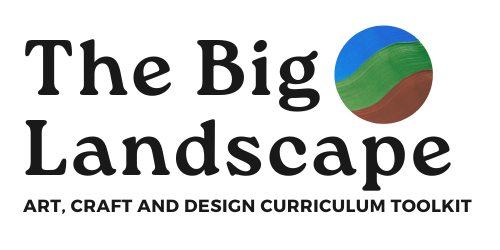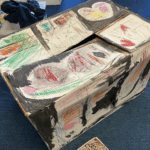Subject matterThe content of art is the meaning, message, and/or feeling imparted by a work of art. Content is inextricably linked with form, which refers to... is used to define how learning is set in a context.
Subject matter provides the context for creating artArt refers to a diverse range of human intellectual and expressive activities and the outcomes of those activities. Within this context art is further defined... and designDesign shapes ideas to become practical solutions and propositions for customers and users. Design is all around us, everything man made has been designed. The....
The work produced will be informed by and will reflect the subject matter.
Subject matter may be taken from a range of sources:
- Personal Memories
- Firsthand hand observations
- Issues of importance (to learnersA learner is an individual who is willing to learn and understand new things. Learning is a process of understanding and acquiring knowledge of new...)
The subject matter should provide valuable opportunities for the development of ideas and creativityCreativity is a characteristic of someone or some process that forms something new and valuable. The created item may be intangible or a physical object.....
Teachers and learners have an immense choice when selecting a subject matter.
It should be carefully chosen giving due consideration to the depth of the learning opportunity and relevance for learners.
If teachers ask learners to recreate artists’ work or engage in tasks to support learning in other subjects they should criticallyArt criticism, is the analysis and evaluation of works of art. More subtly, art criticism is often tied to theory; it is interpretive, involving the effort... think whether such lessons will enable the development of the thinking processes that artistsPeople who are engaged in a broad spectrum of visually led ideas and activities aligned to the expressive arts and designersPeople who are engaged in the production of functional products, services and systems use, such as developing their own ideas.
Some subject matter will provide much better opportunities for learning and progression in art and design than others.
Subject matter that is relevant to the lived experience, interests and aspirations of learners is fundamental for meaningful learning.
Types of subject matter frequently featured in exam contexts include:
- Landscape
- Seascape
- Environment
- FigurativeRepresenting the human form, usually in a naturalistic way.
- Life and Still-life
- Nature
- Narrative
- Descriptive
- Historic
- Representation
- Non-Representation
- Decoration
- PatternA design in which lines, shapes, forms or colours are repeated. E.g. Regular, irregular, repeat, tessellating, symmetrical, natural, geometric, rotation, grid, rhythm, decorative, border. Pattern...
- Ornamentation
- Expressive
- Responsive
- Interpretive
- AbstractWhen applied to art, it usually refers to work which is not representational. Abstract art is concerned with ideas that are drawn away from everyday...
- Conceptual
- Symbolic
- Issue-based
- Meaning
- Satire
- Comic
- Street art
- Cultural
- Social
- Humorous
- Existential
Subject matter can take many forms and themes.
It can involve a critical appreciationCritical appreciation is analysing a work to evaluate its contents and explain why it should be appreciated. of three-dimensional or two-dimensional art or design.
Subject matter can involve stories, fictional or factual from contemporary life or the past.
The directions that subject matter can take are innumerable but from the teacher’s perspective of planning, it is important to ensure that there is a progression in both art and design, that the curriculumIn education, a curriculum (or curricula) is broadly defined as the totality of student experiences that occur in the educational process. The term often refers specifically to a planned... requirements are met, and that subject matter is varied, providing the opportunity for meaningful creativeBeing creative or 'creativity' relates to or involves the use of the imagination or original ideas to create something. work that builds skillsTechniques and attributes acquired through learning, engagement and practice, expressive abilities and most importantly develops learners’ potential.
Subject matter when carefully chosen provides a rich context for creating art and design.
When learners can investigate subject matter of interest it enables them to work in the self-motivated and well-informed way that artists and designers do, bringing their personal experience to bear on the work. For example, in paintingPainting is the practice of applying paint or other media to a surface, usually with a brush. An art object made using paint (noun). a portraitAn art work which represents a particular person (or sometimes animal), often just the head and shoulders. A picture that is portrait way up has..., the subject may be a well-known member of the local community.
The work may be informed by what they have found out about the person for example their early life; their recent achievements and interests.
The portrait may be informed by meeting the person in real life and admiring what they are doing for the community.
- It may be informed by taking photographs in their working environment or collecting information from the mediaDifferent materials used by artists, such as paint, charcoal, clay and thread. Media is the plural of MEDIUM. In this context, it refers to the....
- It may be informed by their knowledgeFacts, information, and skills acquired through experience or education; the theoretical or practical understanding of a subject. of painting styles used by certain portrait artists and the compositions they used.
Overall, their creative intentions will be informed by many things arising from the choice of subject.
It is advisable for teachers to select subject matter which has meaning for their learners rather than for convenience, such as work that is a focus for history this term, or because the school does it every year with this class.
The teacher should apply their own critical thinkingThe ability to reason, ask questions, debate and challenge what is presented to you. and creative thought when choosing subject matter to take account of the opportunities it provides, preferably in association with learners.
References
- See NSEAD Cultural Capital here



